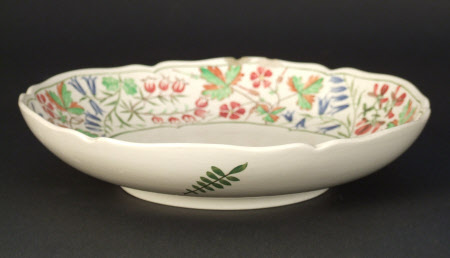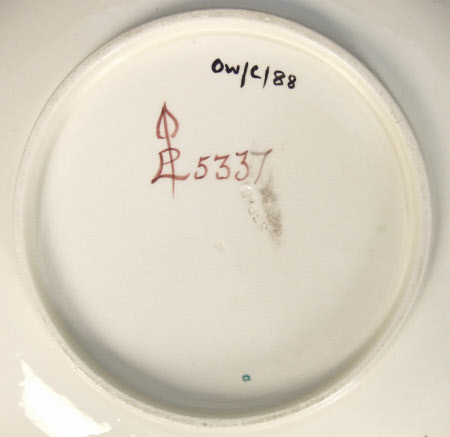Dish
Louise Powell (1882-1956)
Category
Ceramics
Date
1920 - 1930
Materials
earthenware with hand painted decoration
Measurements
49 mm (H); 217 mm (Dia)
Place of origin
London
Order this imageCollection
Owletts, Kent
NT 1410881
Summary
Dish, pale coloured earthenware, shallow form, the rim with six evenly spaced lobes, shallow foot rim, decorated by Louise Powell in London, probably made in Staffordshire, ca 1920-30; decorated by hand with a free flowing design of garden flowers including honeysuckle, bluebells and strawberry plants in naturalistic colours, a lobed green band at the edge of the well and at the rim.
Full description
Ada Louise Powell was a talented painter, calligrapher and embroiderer. She is best known for the intricate, hand-painted ceramics she produced as an independent artist working with pottery manufacturer Josiah Wedgwood & Sons. This plate bears a different, unidentified factory mark, so appears to have been made outside of Powell’s association with Wedgwood. Powell was from a creative family and ceramics were in her blood. Her grandfather Emile Lessore (1805–76) trained at the Sèvres porcelain manufactory in France, before moving to England and joining Minton, later becoming a design consultant for Wedgwood. Her father, Jules, and her sister Elaine Thérèse also painted Wedgwood ceramics. Powell trained in calligraphy and illumination at the Central School of Arts and Crafts in London. An important early commission was the remarkable work she undertook to complete an unfinished illuminated manuscript translation of Virgil’s Aeneid by William Morris (1834–96). The expression, line control, rich level of detail and use of jewel-like colour that she learned through her training translated beautifully into ceramic painting. These qualities can be seen on the flowing garden flowers painted on this plate. Following her marriage to Alfred Powell (1865–1960), Louise began to focus on ceramics. From their studio in Red Lion Square, London, the Powells designed and decorated Wedgwood blanks (undecorated pots), which were sent back to the company factory in Etruria, Stoke-on-Trent, to be fired and sold, often through the London retailer and glassmakers James Powell & Sons. The Powells regularly visited Wedgwood, where they studied the historic pattern books and trained the factory’s decorators in hand-painting on earthenware (at the time, ceramics were decorated mostly by printing). The Powells’ relationship with Wedgwood lasted for 40 years and their work firmly re-established the company’s reputation for artistry and traditional craftsmanship. Many of the artists they nurtured, such as Millicent Taplin and Star Wedgwood, went on to enjoy long and distinguished careers in the Potteries.
Marks and inscriptions
Underside of base: SSP [indecipherable] (factory mark) Underside of base: LP (monogram for Louise Powell) 5337 (production number)
Makers and roles
Louise Powell (1882-1956), decorator


